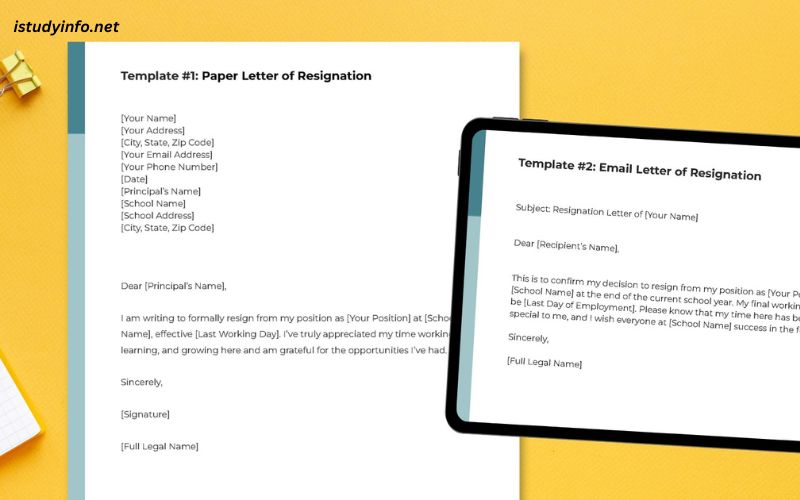As an educator, resigning from your teaching position can be a bittersweet experience. While you may be leaving for personal reasons, it’s essential to handle the transition professionally and maintain a positive relationship with the school administration. Writing a well-crafted teacher resignation letter to the principal is a crucial step in this process.
A thoughtfully written resignation letter serves several important purposes. It allows you to formally notify the school of your decision to resign, outline the effective date of your departure, and express your gratitude for the opportunity to work at the institution. Additionally, it demonstrates your professionalism and commitment to ensuring a smooth transition for your students and the school.
Understanding Personal Reasons for Resigning as a Teacher
Personal reasons for resigning from a teaching position can vary widely. Some common examples include:
- Family Obligations: You may need to prioritize family commitments, such as caring for a sick family member, relocating due to a spouse’s job change, or starting a family of your own.
- Health Concerns: Your physical or mental health may necessitate a change in career path to better accommodate your needs and well-being.
- Pursuing Other Opportunities: You may have decided to explore a different field, pursue advanced education, or take on a new challenge that aligns better with your long-term goals.
- Work-Life Balance: Teaching can be a demanding profession, and you may feel the need to find a better balance between your professional and personal life.
Regardless of the specific reasons, it’s essential to approach the resignation process with care and consideration for the school community you are leaving behind.
Addressing the Letter to the Principal
When drafting your teacher resignation letter, it’s important to address it directly to the principal or school administrator who oversees your employment. This shows respect for the chain of command and ensures that your letter reaches the appropriate decision-maker.
Begin the letter by stating your intention to resign from your teaching position, including the specific date on which your resignation will be effective. Be clear and concise in your communication, as this will help to minimize any confusion or misunderstandings.
Format and Structure of a Teacher Resignation Letter
The format and structure of a teacher resignation letter should follow a standard professional letter format. This typically includes the following elements:
- Heading: Include your name, address, phone number, and email address at the top of the letter.
- Date: Provide the current date on which you are writing the letter.
- Recipient’s Information: Write the principal’s name, title, and the school’s address.
- Salutation: Address the letter to the principal, using a formal salutation such as “Dear [Principal’s Name]”.
- Body Paragraphs: In the body of the letter, clearly state your intention to resign, provide the effective date of your resignation, and express your gratitude for the opportunity to work at the school. You may also want to offer to assist with the transition process or provide any relevant information that could help the school prepare for your departure.
- Closing: End the letter with a professional closing, such as “Sincerely” or “Respectfully,” followed by your handwritten signature and typed name.
Remember to keep the tone of the letter professional and courteous throughout, even if you are resigning due to personal reasons.
Sample Resignation Letter for Personal Reasons
Here is a sample teacher resignation letter for personal reasons:
[Name] [Address] [Phone Number] [Email Address]
[Date]
[Principal’s Name] [Principal’s Title] [School Name] [School Address]
Dear [Principal’s Name],
I am writing to inform you of my resignation from my teaching position at [School Name], effective [Resignation Date]. This decision has been a difficult one, as I have truly enjoyed my time working with the students, faculty, and staff at this institution.
Unfortunately, due to [personal reason, e.g., family obligations, health concerns, pursuing other opportunities, work-life balance], I have made the decision to step down from my role as a teacher. I understand the impact this may have on the school, and I want to assure you that I will do everything in my power to ensure a smooth transition for my students and the school community.
I am grateful for the opportunity to have been a part of the [School Name] team and to have contributed to the education and growth of our students. The experience and knowledge I have gained during my time here have been invaluable, and I will carry them with me as I move forward.
Please let me know if there is anything I can do to assist in the transition process, such as providing detailed lesson plans, student records, or any other relevant information. I am committed to working with you to ensure that my departure has minimal impact on the school and my students.
Thank you for your understanding and support during this time. I wish you and the entire [School Name] community all the best in the future.
Sincerely,
[Your Signature] [Your Name]
Tips for Writing an Effective Letter
As you craft your teacher resignation letter, keep the following tips in mind:
- Be Timely: Provide ample notice, typically 2-4 weeks, to allow the school administration to prepare for your departure and find a suitable replacement.
- Keep it Professional: Maintain a formal and respectful tone throughout the letter, even if you are resigning due to personal reasons.
- Express Gratitude: Acknowledge the positive experiences and opportunities you have had during your time at the school.
- Offer Assistance: Volunteer to help with the transition process or provide any relevant information that could ease the process for the school.
- Avoid Negativity: Refrain from airing any grievances or complaints about the school, your colleagues, or the administration.
- Proofread Carefully: Thoroughly review your letter for any spelling, grammar, or formatting errors before submitting it.
By following these tips, you can ensure that your teacher resignation letter is well-crafted and leaves a positive impression on the school administration.
Resignation Letter Dos and Don’ts
To help you navigate the resignation process, here are some dos and don’ts to keep in mind:
Dos:
- Do provide a clear and specific resignation date.
- Do express gratitude for the opportunities and experiences you’ve had at the school.
- Do offer to assist with the transition process, if possible.
- Do maintain a professional and courteous tone throughout the letter.
- Do proofread the letter carefully before submitting it.
Don’ts:
- Don’t include any negative comments or complaints about the school, your colleagues, or the administration.
- Don’t make any demands or ultimatums in the letter.
- Don’t provide overly personal details about your reasons for resigning.
- Don’t wait until the last minute to submit your resignation letter.
- Don’t use an informal or casual tone in the letter.
By following these guidelines, you can ensure that your teacher resignation letter is well-received and leaves a positive lasting impression.
Importance of Professionalism and Gratitude in the Letter
Maintaining professionalism and expressing gratitude in your teacher resignation letter are crucial for several reasons:
- Preserving Relationships: Even though you are leaving the school, it’s important to maintain positive relationships with the principal, colleagues, and the broader school community. A professional and gracious letter can help to ensure that your departure is viewed in a positive light.
- Protecting Your Reputation: The way you handle your resignation can have a lasting impact on your professional reputation. Demonstrating professionalism and gratitude can help to ensure that you leave on good terms and maintain a positive reputation within the education community.
- Facilitating a Smooth Transition: By offering to assist with the transition process and providing any relevant information, you can help to ensure that the school is well-prepared for your departure and that your students experience minimal disruption.
- Setting a Positive Example: Your teacher resignation letter can serve as a model for future educators who may find themselves in a similar situation. By handling the process with grace and professionalism, you can inspire others to do the same.
Ultimately, the way you approach your teacher resignation can have a significant impact on your future career prospects and the relationships you maintain within the education field.
Submitting the Resignation Letter and Next Steps
Once you have finalized your teacher resignation letter, it’s important to submit it to the principal or designated school administrator in a timely manner. This typically involves:
- Delivering the Letter: You can hand-deliver the letter to the principal’s office or send it via certified mail to ensure that it is received and documented.
- Requesting Confirmation: Ask the principal or administrative assistant to confirm that they have received your resignation letter and understand the effective date of your departure.
- Discussing Next Steps: Schedule a meeting with the principal to discuss the transition process, including any outstanding responsibilities or tasks you need to complete before your last day.
- Informing Colleagues: Notify your colleagues and any other relevant staff members of your resignation, either in person or through a formal announcement.
- Preparing for Departure: Begin organizing your classroom, materials, and any other necessary information to ensure a smooth transition for your replacement.
- Maintaining Professionalism: Throughout the remaining time at the school, continue to demonstrate professionalism and a commitment to your students and the school community.
By following these steps, you can ensure that your teacher resignation is handled in a professional and transparent manner, leaving a positive lasting impression on the school administration and your colleagues.
Conclusion
Resigning from a teaching position, even for personal reasons, can be a challenging and emotional experience. However, by approaching the process with professionalism, gratitude, and a commitment to a smooth transition, you can maintain a positive relationship with the school administration and the broader education community.
Your teacher resignation letter is a crucial component of this process, as it allows you to formally communicate your decision and demonstrate your appreciation for the opportunities you’ve had at the school. By following the tips and guidelines outlined in this article, you can ensure that your letter is well-crafted, respectful, and leaves a lasting positive impression.
Remember, the way you handle your resignation can have a significant impact on your future career prospects and the relationships you maintain within the education field. By prioritizing professionalism and maintaining a positive attitude, you can not only ease the transition for the school but also position yourself for future success.
If you’re a teacher who needs to resign from your position due to personal reasons, consider using the tips and sample letter provided in this article to craft your own professional resignation letter. By handling the process with care and thoughtfulness, you can maintain a positive relationship with the school administration and leave a lasting positive impression.

















Rattling superb visual appeal on this website , I’d rate it 10 10.